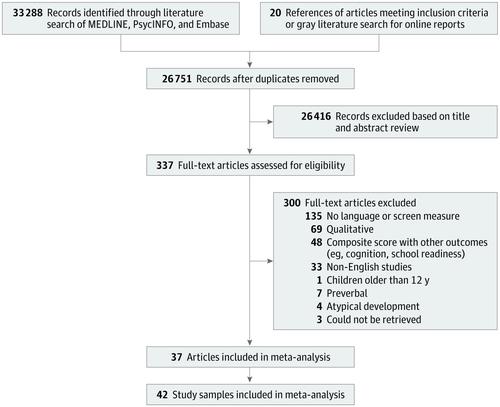当前位置:
X-MOL 学术
›
JAMA Pediatr.
›
论文详情
Our official English website, www.x-mol.net, welcomes your feedback! (Note: you will need to create a separate account there.)
Associations Between Screen Use and Child Language Skills
JAMA Pediatrics ( IF 26.1 ) Pub Date : 2020-07-01 , DOI: 10.1001/jamapediatrics.2020.0327 Sheri Madigan 1, 2 , Brae Anne McArthur 1, 2 , Ciana Anhorn 1, 2 , Rachel Eirich 1, 2 , Dimitri A Christakis 3, 4
JAMA Pediatrics ( IF 26.1 ) Pub Date : 2020-07-01 , DOI: 10.1001/jamapediatrics.2020.0327 Sheri Madigan 1, 2 , Brae Anne McArthur 1, 2 , Ciana Anhorn 1, 2 , Rachel Eirich 1, 2 , Dimitri A Christakis 3, 4
Affiliation

|
Importance
There is considerable public and scientific debate as to whether screen use helps or hinders early child development, particularly the development of language skills. Objective
To examine via meta-analyses the associations between quantity (duration of screen time and background television), quality (educational programming and co-viewing), and onset of screen use and children's language skills. Data Sources
Searches were conducted in MEDLINE, Embase, and PsycINFO in March 2019. The search strategy included a publication date limit from 1960 through March 2019. Study Selection
Inclusion criteria were a measure of screen use; a measure of language skills; and statistical data that could be transformed into an effect size. Exclusion criteria were qualitative studies; child age older than 12 years; and language assessment preverbal. Data Extraction and Synthesis
The following variables were extracted: effect size, child age and sex, screen measure type, study publication year, and study design. All studies were independently coded by 2 coders and conducted in accordance with the Preferred Reporting Items for Systematic Reviews and Meta-Analyses guidelines. Main Outcomes and Measures
Based on a priori study criteria, quantity of screen use included duration of screen time and background television, quality of screen use included co-viewing and exposure to educational programs, and onset of screen use was defined as the age children first began viewing screens. The child language outcome included assessments of receptive and/or expressive language. Results
Participants totaled 18 905 from 42 studies included. Effect sizes were measured as correlations (r). Greater quantity of screen use (hours per use) was associated with lower language skills (screen time [n = 38; r = -0.14; 95% CI, -0.18 to -0.10]; background television [n = 5; r = -0.19; 95% CI, -0.33 to -0.05]), while better-quality screen use (educational programs [n = 13; r = 0.13; 95% CI, 0.02-0.24]; co-viewing [n = 12; r = 0.16; 95% CI, 0.07-.24]) were associated with stronger child language skills. Later age at screen use onset was also associated with stronger child language skills [n = 4; r = 0.17; 95% CI, 0.07-0.27]. Conclusions and Relevance
The findings of this meta-analysis support pediatric recommendations to limit children's duration of screen exposure, to select high-quality programming, and to co-view when possible.
中文翻译:

屏幕使用与儿童语言技能之间的关联
重要性 关于屏幕使用是否有助于或阻碍儿童早期发展,特别是语言技能的发展,存在相当多的公众和科学争论。目的通过荟萃分析检查数量(屏幕时间和背景电视的持续时间)、质量(教育节目和共同观看)以及屏幕使用的开始和儿童语言技能之间的关联。数据源搜索于 2019 年 3 月在 MEDLINE、Embase 和 PsycINFO 中进行。搜索策略包括从 1960 年到 2019 年 3 月的发布日期限制。研究选择纳入标准是对屏幕使用的衡量;语言技能的衡量标准;以及可以转化为效应量的统计数据。排除标准是定性研究;12岁以上的儿童;和语言评估preverbal。数据提取和综合 提取了以下变量:效应大小、儿童年龄和性别、筛选测量类型、研究发表年份和研究设计。所有研究均由 2 名编码员独立编码,并根据系统评价和元分析指南的首选报告项目进行。主要结果和措施 根据先验研究标准,屏幕使用量包括屏幕使用时间和背景电视,屏幕使用质量包括共同观看和接触教育节目,屏幕使用开始定义为儿童第一次使用的年龄开始查看屏幕。儿童语言结果包括接受性和/或表达性语言的评估。结果 纳入的 42 项研究共有 18 905 名参与者。效应大小被测量为相关性(r)。更多的屏幕使用量(每次使用的小时数)与较低的语言技能相关(屏幕时间 [n = 38;r = -0.14;95% CI,-0.18 至 -0.10];背景电视 [n = 5;r = - 0.19;95% CI,-0.33 至 -0.05]),同时使用更优质的屏幕(教育计划 [n = 13;r = 0.13;95% CI,0.02-0.24];共同观看 [n = 12;r = 0.16;95% CI,0.07-.24])与更强的儿童语言技能相关。屏幕使用开始的较晚年龄也与更强的儿童语言技能相关[n = 4; r = 0.17;95% CI,0.07-0.27]。结论和相关性 这项荟萃分析的结果支持儿科建议,以限制儿童接触屏幕的持续时间,选择高质量的节目,并在可能的情况下共同观看。18 至 -0.10];背景电视 [n = 5; r = -0.19;95% CI,-0.33 到 -0.05]),同时使用更优质的屏幕(教育计划 [n = 13;r = 0.13;95% CI,0.02-0.24];共同观看 [n = 12;r = 0.16 ; 95% CI, 0.07-.24]) 与更强的儿童语言技能相关。屏幕使用开始的较晚年龄也与更强的儿童语言技能相关[n = 4; r = 0.17;95% CI,0.07-0.27]。结论和相关性 这项荟萃分析的结果支持儿科建议,以限制儿童接触屏幕的持续时间,选择高质量的节目,并在可能的情况下共同观看。18 至 -0.10];背景电视 [n = 5; r = -0.19;95% CI,-0.33 到 -0.05]),同时使用更优质的屏幕(教育计划 [n = 13;r = 0.13;95% CI,0.02-0.24];共同观看 [n = 12;r = 0.16 ; 95% CI, 0.07-.24]) 与更强的儿童语言技能相关。屏幕使用开始的较晚年龄也与更强的儿童语言技能相关[n = 4; r = 0.17;95% CI,0.07-0.27]。结论和相关性 这项荟萃分析的结果支持儿科建议,以限制儿童接触屏幕的持续时间,选择高质量的节目,并在可能的情况下共同观看。24])与更强的儿童语言技能相关。屏幕使用开始的较晚年龄也与更强的儿童语言技能相关[n = 4; r = 0.17;95% CI,0.07-0.27]。结论和相关性 这项荟萃分析的结果支持儿科建议,以限制儿童接触屏幕的持续时间,选择高质量的节目,并在可能的情况下共同观看。24])与更强的儿童语言技能相关。屏幕使用开始的较晚年龄也与更强的儿童语言技能相关[n = 4; r = 0.17;95% CI,0.07-0.27]。结论和相关性 这项荟萃分析的结果支持儿科建议,以限制儿童接触屏幕的持续时间,选择高质量的节目,并在可能的情况下共同观看。
更新日期:2020-07-01
中文翻译:

屏幕使用与儿童语言技能之间的关联
重要性 关于屏幕使用是否有助于或阻碍儿童早期发展,特别是语言技能的发展,存在相当多的公众和科学争论。目的通过荟萃分析检查数量(屏幕时间和背景电视的持续时间)、质量(教育节目和共同观看)以及屏幕使用的开始和儿童语言技能之间的关联。数据源搜索于 2019 年 3 月在 MEDLINE、Embase 和 PsycINFO 中进行。搜索策略包括从 1960 年到 2019 年 3 月的发布日期限制。研究选择纳入标准是对屏幕使用的衡量;语言技能的衡量标准;以及可以转化为效应量的统计数据。排除标准是定性研究;12岁以上的儿童;和语言评估preverbal。数据提取和综合 提取了以下变量:效应大小、儿童年龄和性别、筛选测量类型、研究发表年份和研究设计。所有研究均由 2 名编码员独立编码,并根据系统评价和元分析指南的首选报告项目进行。主要结果和措施 根据先验研究标准,屏幕使用量包括屏幕使用时间和背景电视,屏幕使用质量包括共同观看和接触教育节目,屏幕使用开始定义为儿童第一次使用的年龄开始查看屏幕。儿童语言结果包括接受性和/或表达性语言的评估。结果 纳入的 42 项研究共有 18 905 名参与者。效应大小被测量为相关性(r)。更多的屏幕使用量(每次使用的小时数)与较低的语言技能相关(屏幕时间 [n = 38;r = -0.14;95% CI,-0.18 至 -0.10];背景电视 [n = 5;r = - 0.19;95% CI,-0.33 至 -0.05]),同时使用更优质的屏幕(教育计划 [n = 13;r = 0.13;95% CI,0.02-0.24];共同观看 [n = 12;r = 0.16;95% CI,0.07-.24])与更强的儿童语言技能相关。屏幕使用开始的较晚年龄也与更强的儿童语言技能相关[n = 4; r = 0.17;95% CI,0.07-0.27]。结论和相关性 这项荟萃分析的结果支持儿科建议,以限制儿童接触屏幕的持续时间,选择高质量的节目,并在可能的情况下共同观看。18 至 -0.10];背景电视 [n = 5; r = -0.19;95% CI,-0.33 到 -0.05]),同时使用更优质的屏幕(教育计划 [n = 13;r = 0.13;95% CI,0.02-0.24];共同观看 [n = 12;r = 0.16 ; 95% CI, 0.07-.24]) 与更强的儿童语言技能相关。屏幕使用开始的较晚年龄也与更强的儿童语言技能相关[n = 4; r = 0.17;95% CI,0.07-0.27]。结论和相关性 这项荟萃分析的结果支持儿科建议,以限制儿童接触屏幕的持续时间,选择高质量的节目,并在可能的情况下共同观看。18 至 -0.10];背景电视 [n = 5; r = -0.19;95% CI,-0.33 到 -0.05]),同时使用更优质的屏幕(教育计划 [n = 13;r = 0.13;95% CI,0.02-0.24];共同观看 [n = 12;r = 0.16 ; 95% CI, 0.07-.24]) 与更强的儿童语言技能相关。屏幕使用开始的较晚年龄也与更强的儿童语言技能相关[n = 4; r = 0.17;95% CI,0.07-0.27]。结论和相关性 这项荟萃分析的结果支持儿科建议,以限制儿童接触屏幕的持续时间,选择高质量的节目,并在可能的情况下共同观看。24])与更强的儿童语言技能相关。屏幕使用开始的较晚年龄也与更强的儿童语言技能相关[n = 4; r = 0.17;95% CI,0.07-0.27]。结论和相关性 这项荟萃分析的结果支持儿科建议,以限制儿童接触屏幕的持续时间,选择高质量的节目,并在可能的情况下共同观看。24])与更强的儿童语言技能相关。屏幕使用开始的较晚年龄也与更强的儿童语言技能相关[n = 4; r = 0.17;95% CI,0.07-0.27]。结论和相关性 这项荟萃分析的结果支持儿科建议,以限制儿童接触屏幕的持续时间,选择高质量的节目,并在可能的情况下共同观看。


























 京公网安备 11010802027423号
京公网安备 11010802027423号